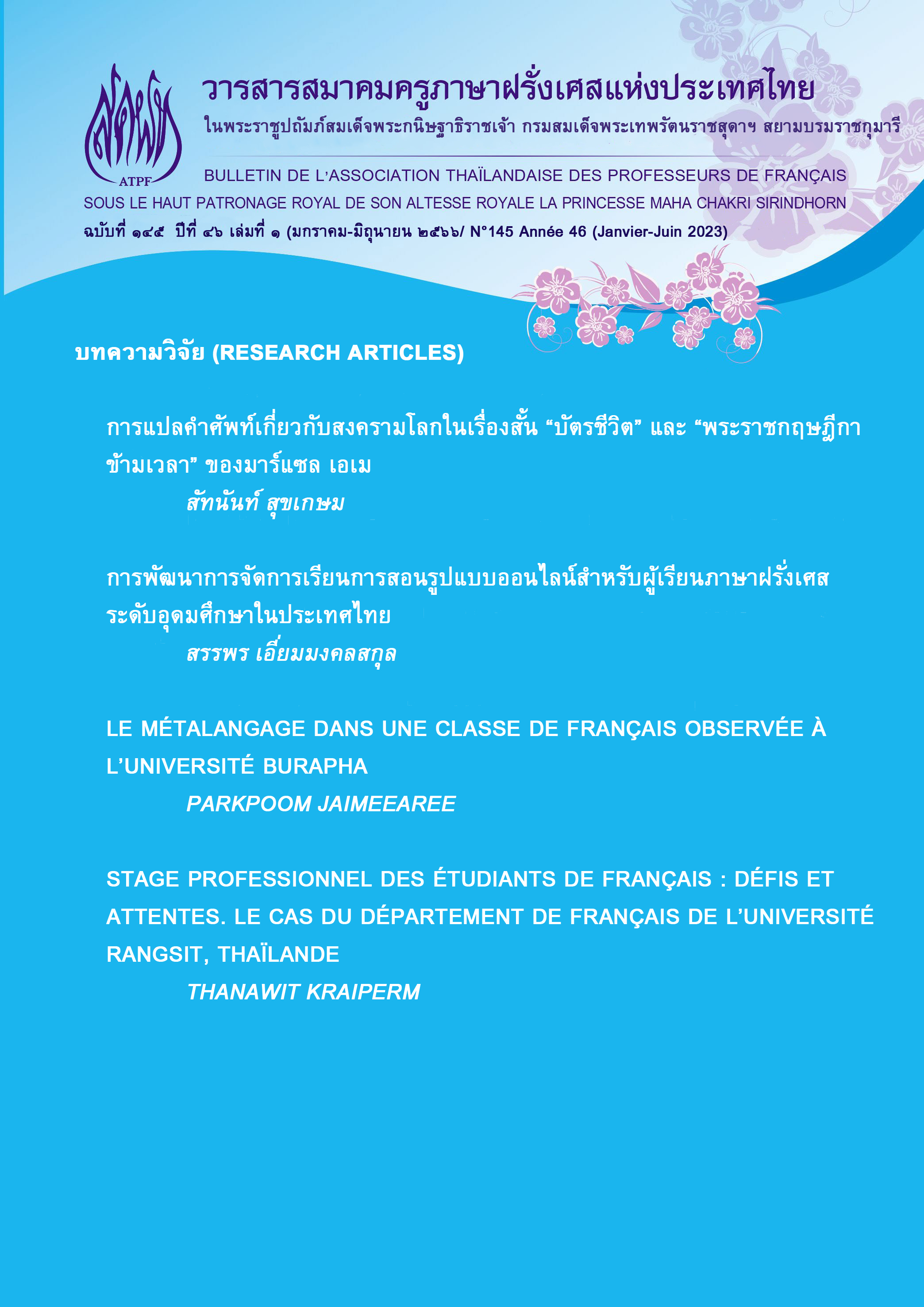การแปลคำศัพท์เกี่ยวกับสงครามโลกในเรื่องสั้น “บัตรชีวิต” และ “พระราชกฤษฎีกาข้ามเวลา” ของมาร์แซล เอเม
Main Article Content
บทคัดย่อ
บทความนี้มีวัตถุประสงค์เพื่อศึกษาการแปลคำศัพท์เกี่ยวกับสงครามโลกในเรื่องสั้น “บัตรชีวิต” (La carte) และเรื่อง “พระราชกฤษฎีกาข้ามเวลา” (Le décret) ของมาร์แซล เอเม (Marcel Aymé) ซึ่งดำเนินเรื่องในระหว่างที่กองทัพเยอรมันเข้ายึดครองประเทศฝรั่งเศส (L’Occupation allemande) ในช่วงสงครามโลกครั้งที่สอง บริบททางประวัติศาสตร์จึงเป็นส่วนสำคัญของเรื่อง นอกจากนี้ มาร์แซล เอเมใช้วิธีการเล่าเรื่องสั้นทั้งสองเรื่องนี้แบบบันทึกส่วนตัว ตัวละครผู้ดำเนินเรื่องเขียนบรรยายชีวิตประจำวัน อาหารการกิน การเดินทางไปยังสถานที่ต่าง ๆ รวมถึงการพบปะผู้คน รายละเอียดเหล่านี้ทำให้ผู้วิจัยพบคำศัพท์ที่ใช้เฉพาะในช่วงเวลาดังกล่าว ซึ่งยากต่อการแปลเป็นภาษาไทย เนื่องจากการรับรู้ของคนฝรั่งเศสและคนไทยไม่เหมือนกัน จึงต้องหาวิธีการถ่ายทอดความหมายที่จะทำให้ผู้อ่านเข้าใจคำศัพท์เหล่านี้ ผู้วิจัยใช้วิธีเปรียบเทียบสถานการณ์สงครามระหว่างฝรั่งเศสและไทย และพบว่าคำศัพท์บางคำสามารถแปลได้เมื่อนำมาเปรียบเทียบ เพราะในบริบทของไทยก็มีเหมือนกัน แต่ก็มีคำศัพท์บางคำที่ใช้เฉพาะกับเหตุการณ์ในประเทศฝรั่งเศส ซึ่งไม่พบในประเทศไทย จึงต้องหาวิธีอื่น ๆ มาถ่ายทอดความหมายแทนการแปลแบบตรงตัว เพื่อให้บทแปลสื่อความหมายและทำให้ผู้อ่านเข้าใจเนื้อเรื่อง คำแปลศัพท์ที่นำมาวิเคราะห์ในบทความนี้แบ่งออกเป็น 4 กลุ่ม ได้แก่ สิ่งของและสถานที่ เครื่องแบบทหาร ยุทธการทางทหาร และตำแหน่งยศของทหาร
Downloads
Article Details
เอกสารอ้างอิง
กระทรวงกลาโหม. (2542). กฎกระทรวง (พ.ศ. 2542) ออกตามความในพระราชบัญญัติเครื่องแบบทหาร พุทธศักราช 2477 ว่าด้วยเครื่องแบบทหารบก ฉบับที่ 80. สืบค้นเมื่อ 26 ตุลาคม 2565, จาก https://dop.rta.mi.th/uniform/data/01/1/uniform.pdf
กระทรวงกลาโหม. (2555). ข้อบังคับกระทรวงกลาโหมว่าด้วยสารวัตรทหาร พ.ศ.2555. สืบค้นเมื่อ 26 ตุลาคม 2565, จาก https://mpb.rtarf.mi.th/PDF/ข้อบังคับ%20กห.ว่าด้วยสารวัตรทหาร2555.pdf
ปรัชญากรณ์ ลครพล. (2564). กองทัพคณะราษฎร. พิมพ์ครั้งที่ 1. กรุงเทพฯ: มติชน.
ประเสริฐ ปัทมะสุคนธ์. (2517). รัฐสภาไทยในรอบสี่สิบสองปี (2475-2517). พิมพ์ครั้งที่ 2. กรุงเทพฯ : กุล่มรัฐกิจเสรี.
พวงทิพย์ เกียรติสหกุล. (2553). ชีวิตราษฎรไทยสมัยสงครามมหาเอเชียบูรพา: มุมมองผ่านการเข้ามาควบคุมทางรถไฟสายใต้ของกองทัพญี่ปุ่น. วารสารมหาวิทยาลัยศิลปากร ฉบับภาษาไทย, 30(1), 117-137.
วิชนัญ กลั่นรอด. (2556). ศาสตราจารย์ศิลป์ พีระศรีกับมุเนะทสึกุ สะโตะมิ และความร่วมมือที่นำไปสู่การจัดแสดงศิลปกรรมแห่งชาติ. วารสารวิชาการคณะจิตรกรรมประติมากรรมและภาพพิมพ์ มหาวิทยาลัยศิลปากร, 1(1), 109-128.
อาชญาสิทธิ์ ศรีสุวรรณ. (2561). ทัศนคติเรื่องญี่ปุ่นในงานเขียนของ ‘วิตต์ สุทธเสถียร’ เจ้าพ่อสำนวนสวิงคนแรกๆ ของไทย. สืบค้นเมื่อ 27 ตุลาคม 2565, จาก https://thematter. co/thinkers/thai-writer-and-japanese-soldier/62139
อาทิตย์ วงษ์สง่า. (2562). ศาสตร์การแปลในทัศนะของอ็องตวน แบร์มาน. วารสารสมาคมครูภาษาฝรั่งเศสแห่งประเทศไทย ในพระราชูปถัมภ์ฯ, 42(2), 79-98.
Arnold, D. (2017). Les prisonniers de guerre français de la Seconde Guerre mondiale. Retrieved October 25, 2022, from https://www.archives18.fr/recherches/ guides- et-fiches-pratiques/les-prisonniers-de-guerre-francais-de-la-seconde-guerre-mondiale
Aymé, M. (1972). Le passe-muraille. Paris : Gallimard.
De Chalendar, A. (2016). Vivre d'Ersatz pendant la guerre. Retrieved October 24, 2022, from https://france3-regions.francetvinfo.fr/grand-est/vivre-d-ersatz-pendant-la-guerre-1010277.html
Gendarmerie nationale. (2022). Cinq cent ans d'histoire. Retrieved October 24, 2022, from https://www.gendarmerie.interieur.gouv.fr/notre-institution/la-gendarmerie-nationale/cinq-cent-ans-d-histoire
Grenard, F. (2008). La France du marché noir: 1940-1949. Retrieved October 26, 2022, from https://books.google.co.th/books?id=_94TAQAAIAAJ&dq=La%20France %20du%20marché%20noir%20(19401949)%20Fabrice%20Grenard&hl=th&source=gbs _book_other_versions.
Haberbusch, B. (2007). Le sort des gendarmes juifs sous l’Occupation. Revue d’Histoire de la Shoah, 187, p. 329-340. https://doi.org/10.3917/rhsho.187.0329
Ministère de la défense. La ligne de démarcation (collection « Mémoire et Citoyenneté » n°7). Retrieved October 27, 2022, from http://www.civs.gouv.fr/images/pdf/ documents_utiles/documents_dhistoire/La_li gne_de_demarcation.pdf
Petri, H. (2006). Journal de marche d'un fantassin allemand (1941-1945) "C'était ainsi". France : L’Harmattan.
Pfeiffer, S. (2021). Alsace : en 1914-1918, nos ancêtres n'étaient pas des poilus, mais des feldgraus, des soldats "verts-de-gris" allemands. Retrieved October 21, 2022, from https://france3-regions.francetvinfo.fr/grand-est/alsace/alsace-en-1914-18-nos-ancetres-n-etaient-pas-des-poilus-mais-des-feldgrauen-des-soldats-verts-de-gris-allemands-2339563.html
Szczypiorski, A. (1988). La Jolie Madame Seidenman. Paris : Fallois.
Zanon, F. (2013). 4H30-325 Seconde Guerre mondiale et occupation allemande (1935-1960). Retrieved October 22, 2022, from https://www.ville-cormeilles95.fr/ sites/cormeilles-en-parisis/files/document/article/4h_2ndegm.pdf


